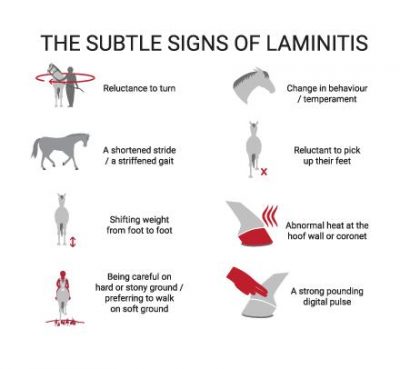There are only two kinds of horses…. those that have laminitis and those that could someday get it!
So what is laminitis and how do horses get it?
Put simply, laminitis is the inflammation of the sensitive laminar corium in the hoof, causing a breakdown of the bond between the hoof wall and the coffin bone.
Severe cases are commonly known as founder and major causes are by eating sugar-rich grasses, but it can also be caused by concussion of the hooves on hard surfaces, over-eating grain, infection from retaining afterbirth, excessive weight bearing on one leg, stress, vaccinations, and medications.
There are many good books giving much greater detail on the causes and treatments, so if you own a horse, you should be aware of how this condition occurs and how to keep your horse from suffering it.
The early clinical signs of laminitis are:
- Reluctance to move freely (especially on hard/rough surfaces).
- Blood stains are visible on the white line or hoof wall.
- Pulse and respiration may be elevated due to pain.
- When moving, prefers to canter rather than trot if given a choice.
- Feet are off balance – may have long toes, high heels, or both.
- Moves forward soundly but takes slightly shorter than normal strides.
- Sound on soft terrain but may limp or stumble on hard or rocky ground.
- Sole bruising and a stretched white line (in some horses, by the time you see this they have been compromised for quite some time).
Late clinical signs: (Founder)
- Lies down a lot
- Standing but will not move
- Bounding digital pulse
- Sole hot to the touch
- White line stretched
- Will not allow you to pick up a foot
- Stops eating
- Sole bruise in the shape of a coffin bone
- Shifting weight from foot to foot (swaying side to side).
- Standing with front legs stretched out, back arched, trying to lean back to get the weight off toes.
- When asked to turn in a tight area like a stall or narrow barn aisle the horse rocks backward onto haunches, lifts its head up, and lurches around because it hurts to turn the feet.

Usually several of these signs will appear together or appear over the course of a few days.
All of the signs need to be evaluated in context. No single indicator would be diagnostic for laminitis.
If you suspect your horse has laminitis or founder then do your research, ask many opinions from varied sources (natural hoof care practitioners, vets, farriers) and communicate with others who have successfully rehabilitated a foundered horse or pony.
Then DO something about it – just hoping that early signs will go away is leading to a severe case which is more painful for your horse and your pocket!
Better still, assess your horse’s situation before it occurs;
- Do you have hooves trimmed regularly? (ie: every 4 weeks – not 8, 10, or 12) to maintain good hoof balance and health.
- What is the diet? Grains, lucerne, rich grass, or a fresh flush of grass all cause laminitic attacks.
- What stresses does your horse endure? Traveling, competing, overtraining, illness, vaccinations, de-worming and medicating can all be triggers for laminitis.
Because laminitis is a “whole horse disorder” a holistic approach works well to identify and correct the root cause.
Be especially vigilant as spring grasses are starting to emerge. Restrict access to grass during the later part of the day and at night, and keep feeding plenty of hay so your horse doesn’t feel the need to gorge on toxic grass.
For more detailed information on Laminitis and Founder go to articles at www.safergrass.org and www.naturalhorsetrim.com
FABULOUS ONLINE VIDEOS ALL HORSE OWNERS NEED TO SEE – learn more about the dangers of over-feeding your horse and how to tell if they are overweight. Click this link to Fran Jurga’s Hoofblog to read more about how we inadvertently overfeed our horses and cases of laminitis are rising as a consequence – the videos are each about 7-9 minutes long.
https://hoofcare.blogspot.com/2008/12/favorite-video-horse-owners-should.html




My Welsh mountain A section pony founded in early may had vet out strict diet boots on and 2mls of thrush applied to hooves, as he getting better vet advice to shod him till better after each trim he gets sore question is can I show him in ring with shoes on?? Till he is better again… Cheers Robbie
Hi Robbie,
sorry for the slow reply – just saw your question. By wearing shoes your pony is having the symptoms of laminitis (founder) masked as indicated by the soreness after a trim. So by showing your pony you are providing movement which does help with circulation and healing, however restricting circulation with shoes doesn’t, and long term the shoes are probably doing more harm. Personally, I’d be looking into hoof boots to provide some protection while you gradually increase exercise (and hopefully you are already addressing the diet) while giving the hooves a chance to heal as they grow out. This could take many months and up to a year so you need to be careful about the type of exercise you ask for – no tight turns or jumping/galloping. Lots of trotting in straight lines is best if the pony can do this in padded hoof boots without being lame. I hope this helps.
Cheers, Cynthia.